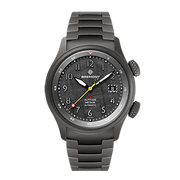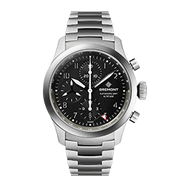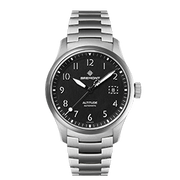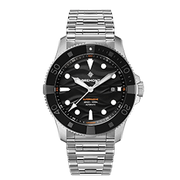A mechanical watch is a hand-built precision instrument so at Bremont we recommend a routine service every three to five years. A service is essential to keep it in good working order and maintain its value as an investment piece. Here's what goes into a typical Bremont service...
Step 1: Inspection and Diagnosis
The first step is a thorough visual check of the watch in which photographs are taken; the condition of the case, crystal and case components are marked on a diagram on the booking-in form. The hand alignment, functioning of the crown, pushers and Roto-Click are all checked. A chronoscope is used to assess timing; the date change, chronograph and GMT functions are all tested. The watch is de-magnetised, if necessary. The customer is then consulted to confirm whether they would like any cosmetic damage corrected and a quotation for recommendations and work required is produced. The watch is held until the quotation is approved; once the customer has agreed that the work can proceed it can be allocated to watchmaker.
Step 2: Uncasing
Once in the workshop, the bracelet or strap is removed from the watch and the case is dismantled; the crown, pendent tube, pushers and correctors are removed and the crystal is pressed out. All existing gaskets and seals are discarded. The movement, in its mount, is taken out and passed onto the allocated watchmaker.

Step 3: Case Renovation
All external case components are cleaned and polished or replaced, depending on the customer request and case material. Top bezels made from hardened steel, or with a DLC finish, and MB decoration rings are replaced (with approval) as they cannot be polished. Rose gold cases are polished to best possible standard, without compromising their shape. Worn or damaged case components are also replaced, along with bracelet screws and spring bars. All other parts are ultrasonically cleaned. Bracelets are steam cleaned with 8 bars of pressure to ensure internal parts are thoroughly cleaned.
Step 4: Case Re-assembly
The new and renovated parts are re-assembled with the replaced gaskets for sealing and shock-proofing and the crystal. The completed case is then depth and pressure tested for water resistance.

Step 5: Movement Dismantling
The hands, dial and movement mount are removed and stored with the newly renovated watch case. The movement itself is de-magnetised and then completely dismantled into its constituent parts of up to 150 individual pieces (depending on the complication).
At this point, component parts may be cleaned using special fluids, to aid inspection.

Step 6: Inspection
Each movement component is individually inspected to identify any damage and to ensure it is within tolerance. For example, the condition of teeth, pivots and bearings are checked and parts examined for evidence of surface scoring. The Jewels are cleaned and polished individually using a traditional hornbeam wooden peg, which facilitates the removal of old lubricants. Loupes of varying magnification and a microscope are used to carry out inspection.
Step 7: Replacing
All worn, damaged or evolved movement parts are replaced, as required. At Bremont the main barrel (containing the main spring), the reversers and rotor bearings are all replaced as standard during a service.

Step 8: Cleaning
The movement components are carefully sorted into a range of baskets of differing sizes so that they can be ultrasonically and mechanically cleaned. An array of fluids and specialist equipment are used; cleaning and drying takes approximately 45 minutes. The special rotors from Limited Edition watches are meticulously hand cleaned due to the precious materials that have been incorporated as part of their unique structure.
Step 9: Rebuilding and lubricating
The movement can now be rebuilt using the cleaned and replaced parts. Correct lubrication of each component is critical, so specific surface treatments are individually applied. As many as 8 different oils or greases may be used in a single movement, depending on the properties and characteristics required by each part. These are applied using tiny oil 'picks' which hold different 'droplet' sizes of oil that are painstakingly applied to every bearing and interaction point on the movement. Loupes of up to 20x magnification are used to enable application of pin-point accuracy and quantity judgements. The sequence of assembly must be memorized by the watchmaker and followed precisely, adjustments are made as new parts are married to the movement, this process takes hours of concentration by highly skilled watchmakers.

Step 10: Regulating and Testing
The rebuilt movement is de-magnetised again as the use of metal instruments during the handling, cleaning and rebuilding may have caused the components to become magnetised. It can now be regulated using a bench chronoscope to assess timing accuracy and the need for adjustment, before being moved on for testing in 5 different positions. Each core range watch movement is regulated to an accuracy of -4 to +6 seconds per day; some Limited Editions work to different parameters.

Step 11: Refitting
The dial and hands are refitted onto movement. Bremont watchmakers replace hands during a service, as standard.

Step 12: Casing up and Regulation
The movement and case are re-married, the timing is tested once more, using the watchmaker's bench chronoscope and any required regulation adjustments are made.

Step 13: Water resistance testing
The watch head is pressure tested with a full depth test, encompassing overpressure ratings, designed to ensure that the watch is able to perform at the required pressure.
Step 14: Testing
A cyclomat, which simulates wrist winding, is used to fully wind the watch (over 4, 6, or 8 hours, depending on the movement type). Timing tests are conducted and recorded at zero hours and again after 24 hours; the watch is then run down completely to test the power reserve, which may take up to 48 hours for a core range watch (or even 8 days for a Supersonic).
Step 15: Quality Control
The strap or bracelet is fitted once more and the watch returned to diagnostics for final QC. The hand alignment, functioning of the crown, pushers and Roto-Click are all checked again. A chronoscope is used to confirm timing accuracy; the date change, chronograph and GMT function are all tested again. Finally, a full visual check of the aesthetics is carried out. The fully serviced watch is now ready to be returned to its owner.













